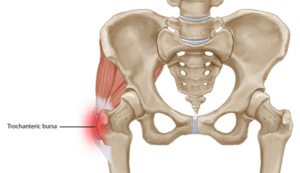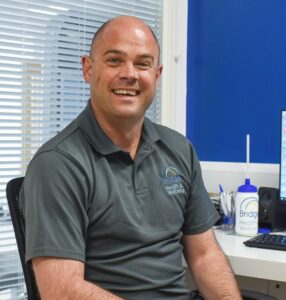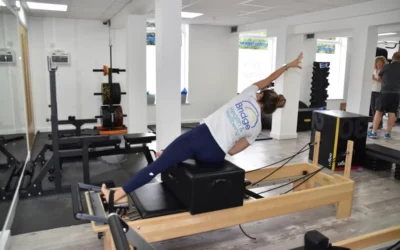Pain on the side of your hip or thigh is more than likely caused by the structures that are involved with the greater trochanter of the thigh bone (femur). If you touch the outside of your leg and feel a bony lump, this is your greater trochanter. For many years we thought that it was the bursa in that area that was affected, so you may have heard of trochanteric bursitis. This can still be affected, but equally, we now understand that the gluteal muscles that attach to that area of the femur are more than likely involved as well.

- Greater trochanteric pain syndrome – (GTPS) is a common clinical syndrome that used to be called trochanteric bursitis.
- More common in females F:M = 4:1
- More common in 40-60-year-old patients
- Occurs in 10-25% of the population
Symptoms
The main symptom you will experience is pain specifically on the outside of the thigh, which can radiate down the leg a short distance. If the symptoms continue, you may start to notice some weakness around the hip and pelvis and even start to limp. These are some of the activities that can be painful:
- Walking long distances
- Walking on uneven ground
- Walking downhill and coming downstairs
- Lying on the affected side due to the compression/pressure on the leg
- Lying on the un-affected side due to the leg stretching over
What can we do
You might not have felt like you have injured your leg/hip, and this is often the case as lateral hip pain tends to be an overuse condition whereby the muscles are getting loaded repetitively through all your normal activities plus any additional sports or hobbies you might do and just don’t have enough time to recover and get stronger.
Following an initial assessment by a physiotherapist, to fully rule out any other pathology, we would start you on a rehabilitation programme of targeted loading exercises aimed at strengthening your glute and lower limb muscles. We would also advise on things like weight loss, stretches and activity modification.
Sometimes an injection into the area can help reduce the symptoms for a short period which then allows you to complete more of your rehab, which is the most important part of treating lateral hip pain. Depending on the severity of the symptoms, it can take 2-3 months to see any significant improvement, but there should be no reason why the symptoms don’t resolve completely with a well-structured rehabilitation plan.
If you have hip pain or your hip is having an impact on your daily life and activity, please get in touch. To speak to our physiotherapist Paul or book your physiotherapy appointment at our health and wellness centre on Bridge Street in Christchurch, Dorset, please contact us at 01202 473800 or book online.

Paul O’Connell (MSC, BSC, HCPC, MCSP) is a physiotherapist with two decades of clinical expertise. He has worked right across the UK, from North Yorkshire and London to Hampshire and Dorset. Sports medicine is one of his areas of special interest: he has worked both on the touchline and in sports injuries clinics and now lectures on the Sports Therapy programme at Bournemouth University. Having spent several years managing physiotherapy and health assessment teams in two key Nuffield Health hospitals, Paul also has an extensive understanding of orthopaedic surgery.



